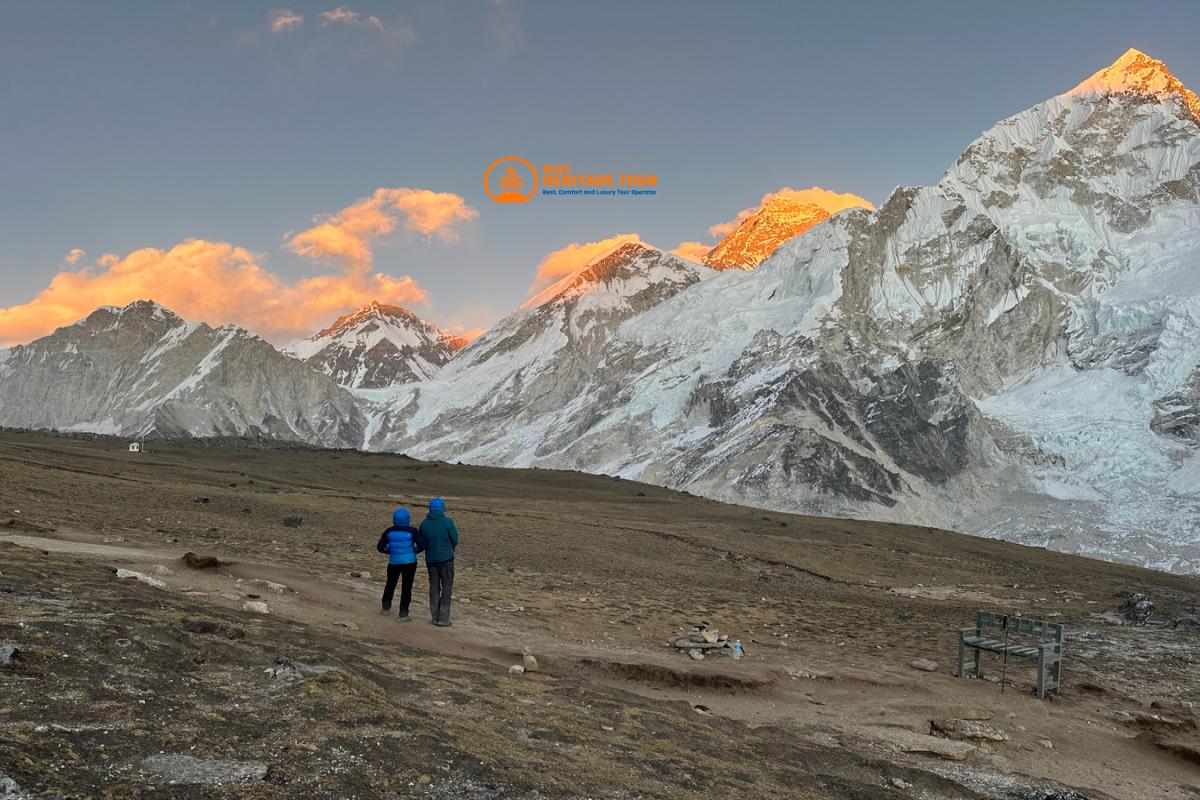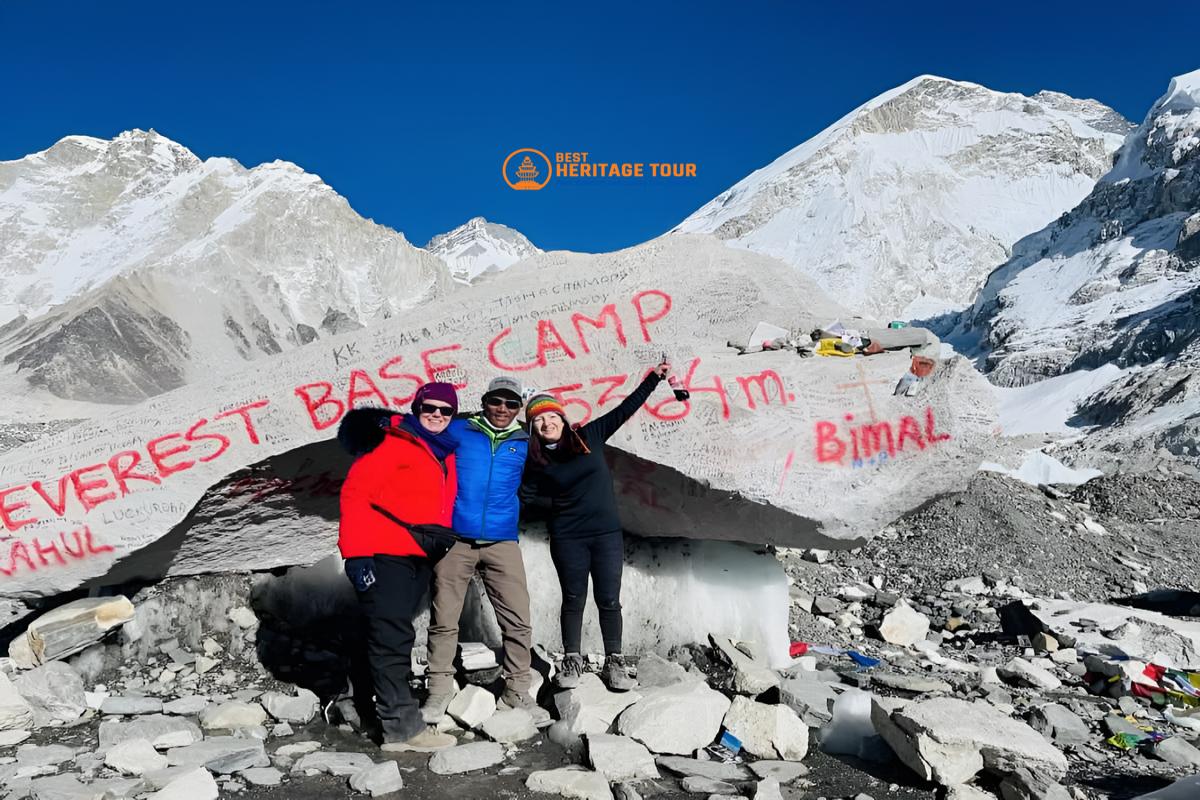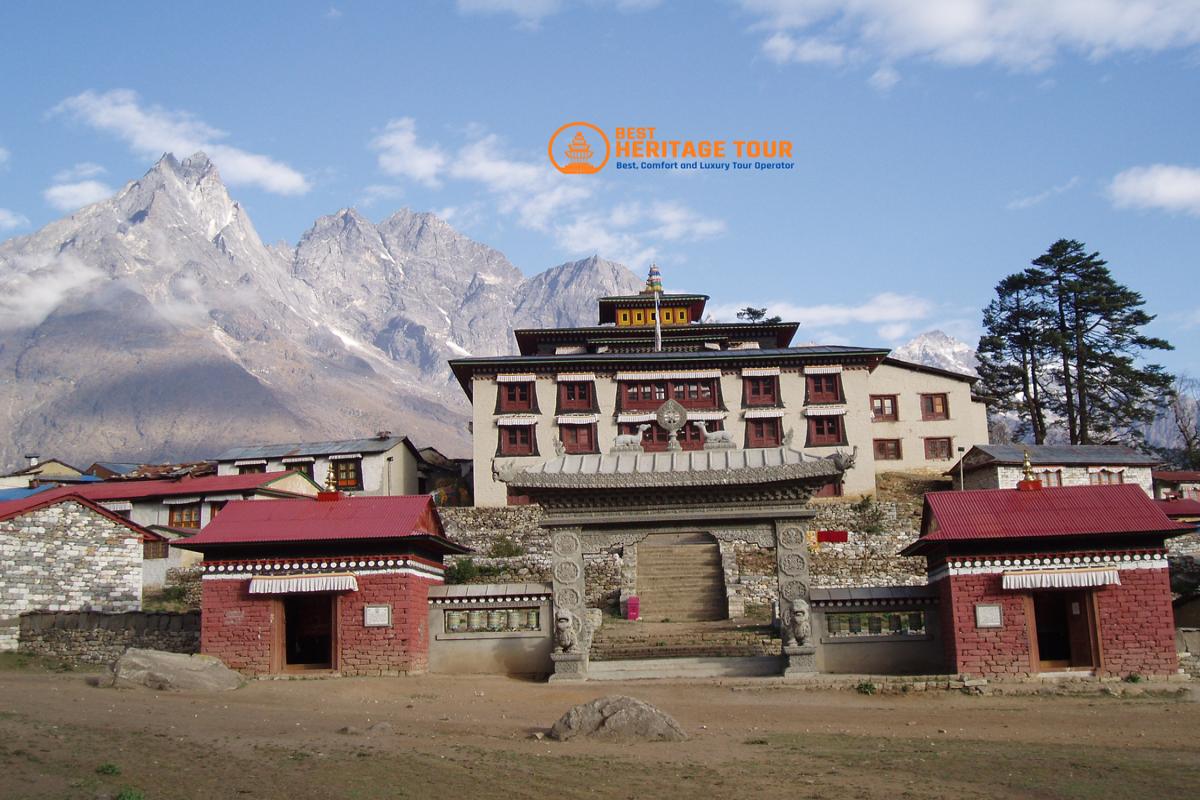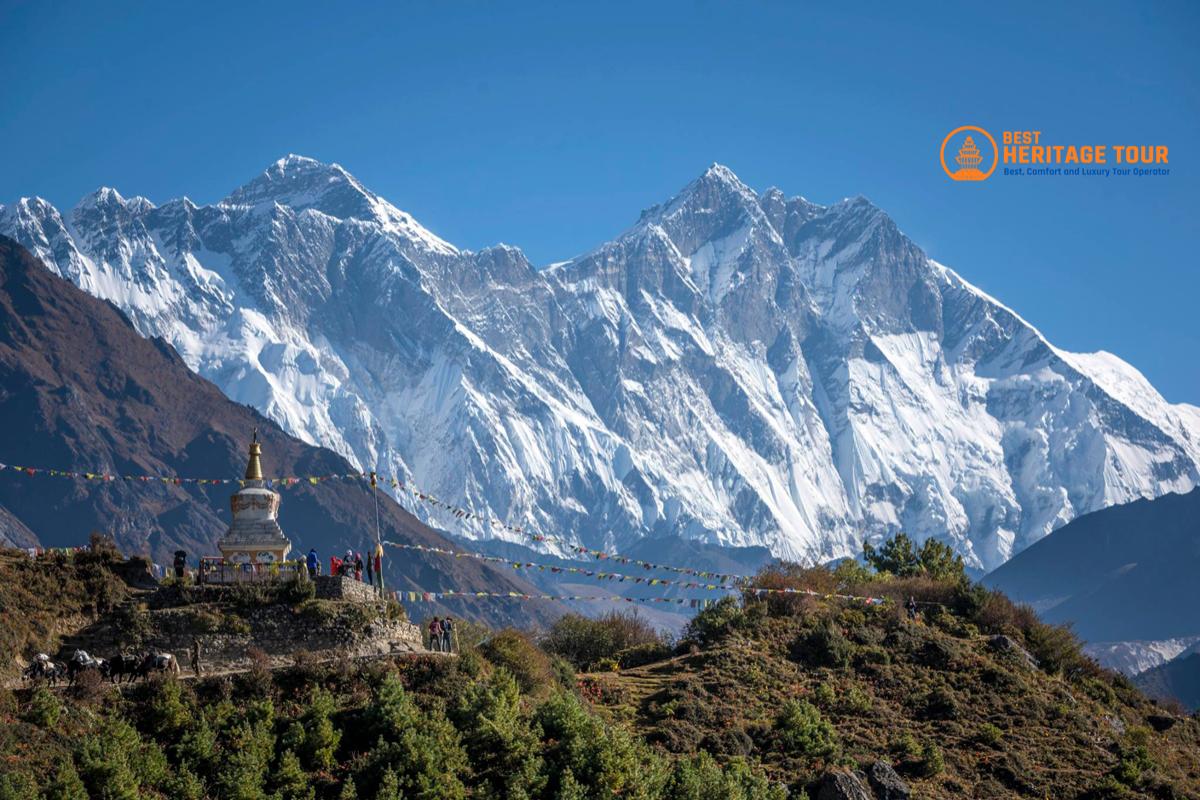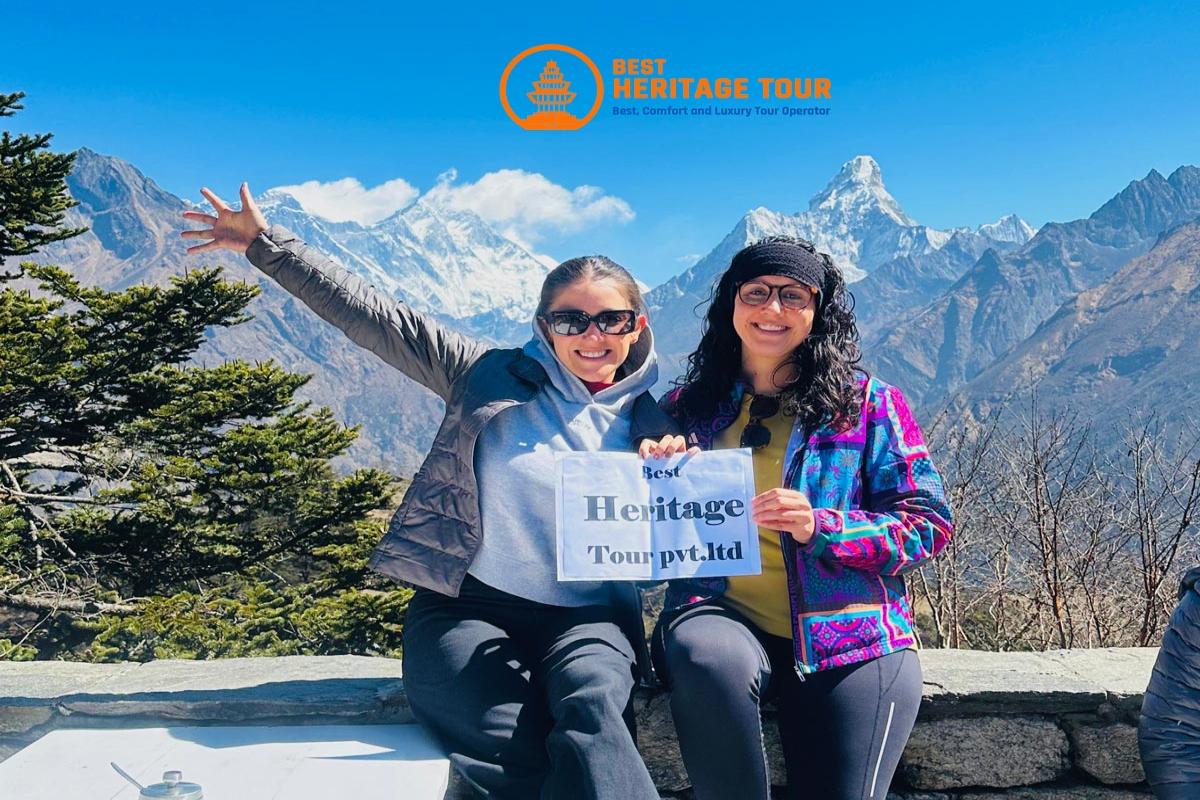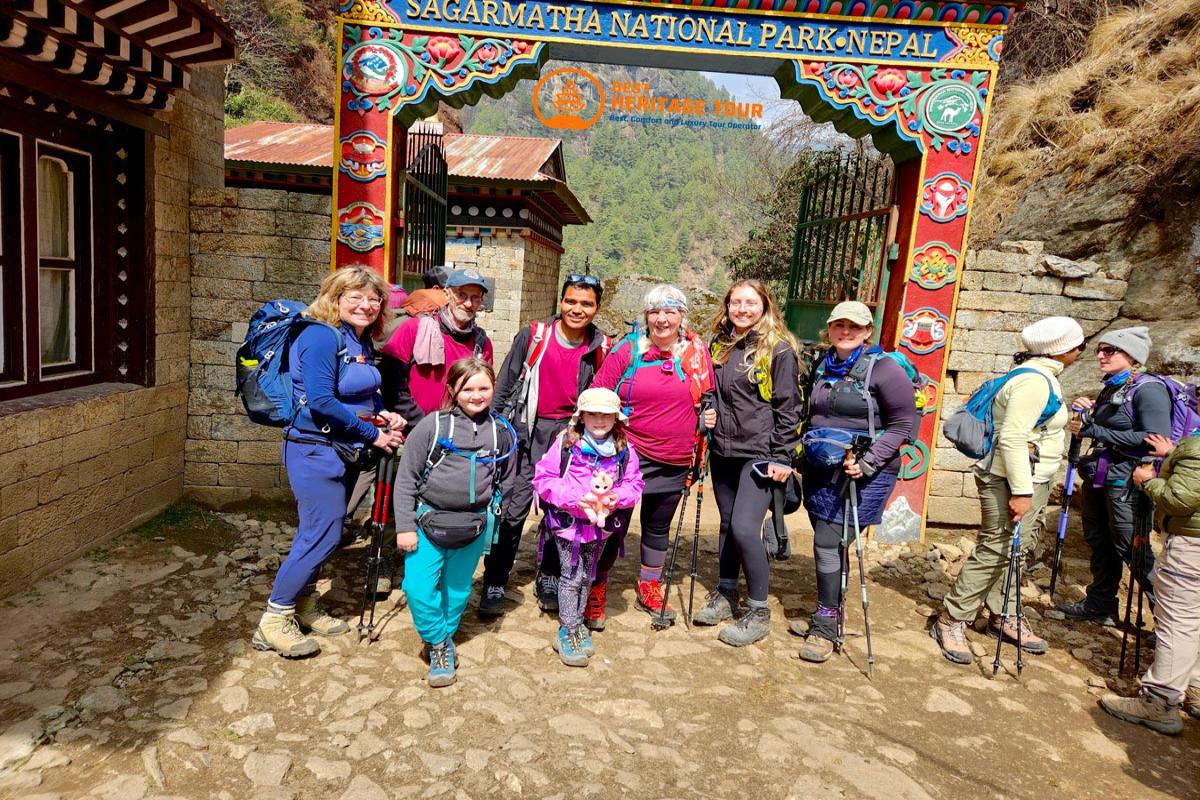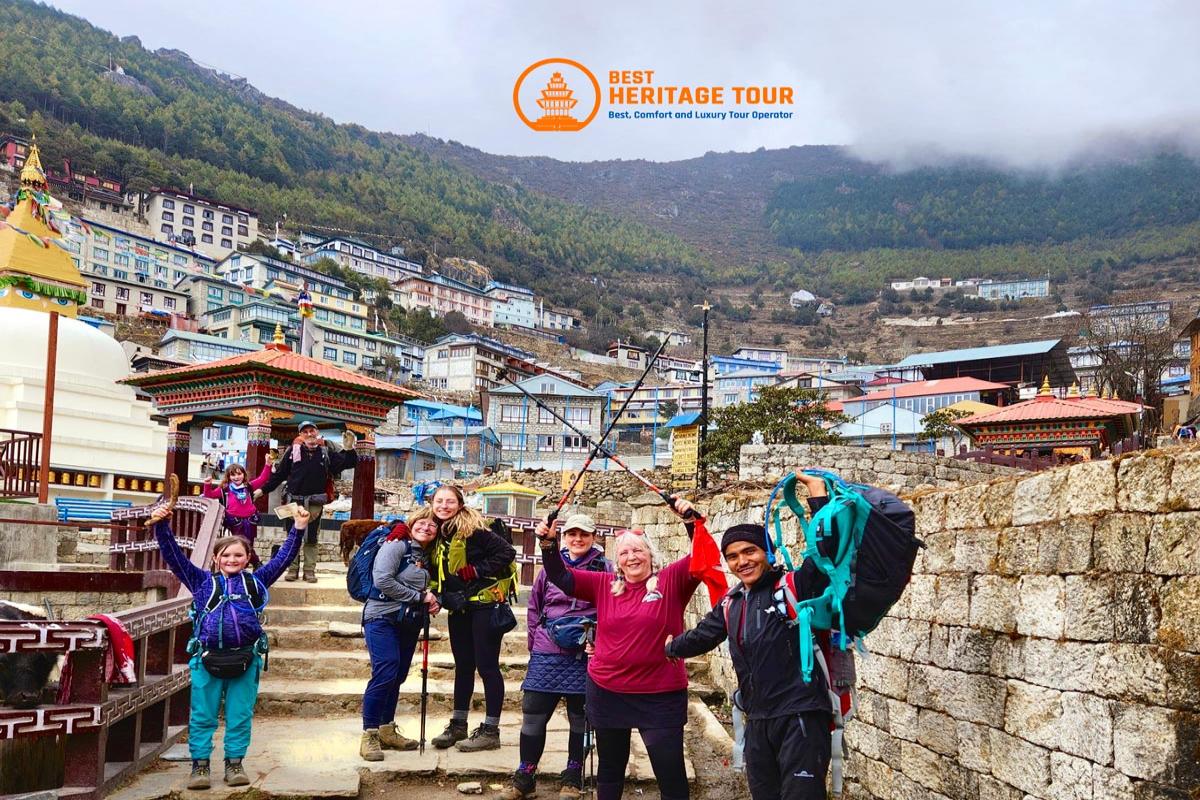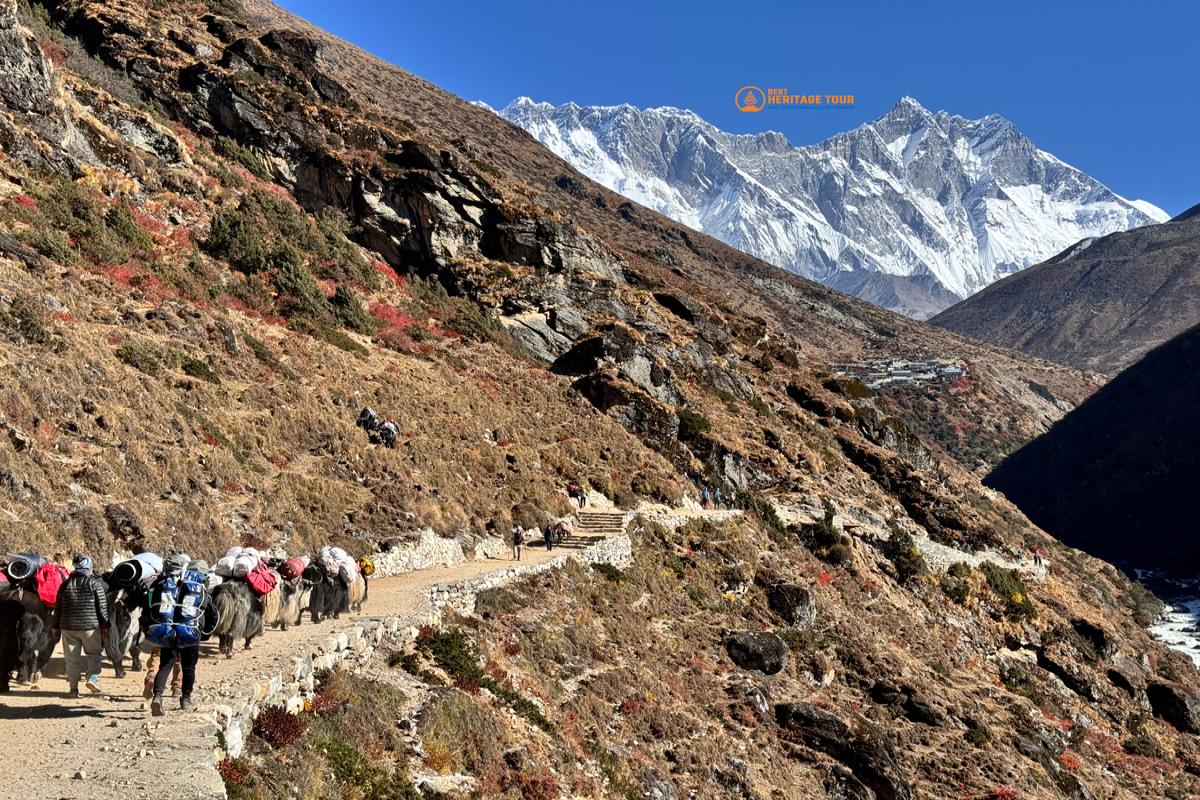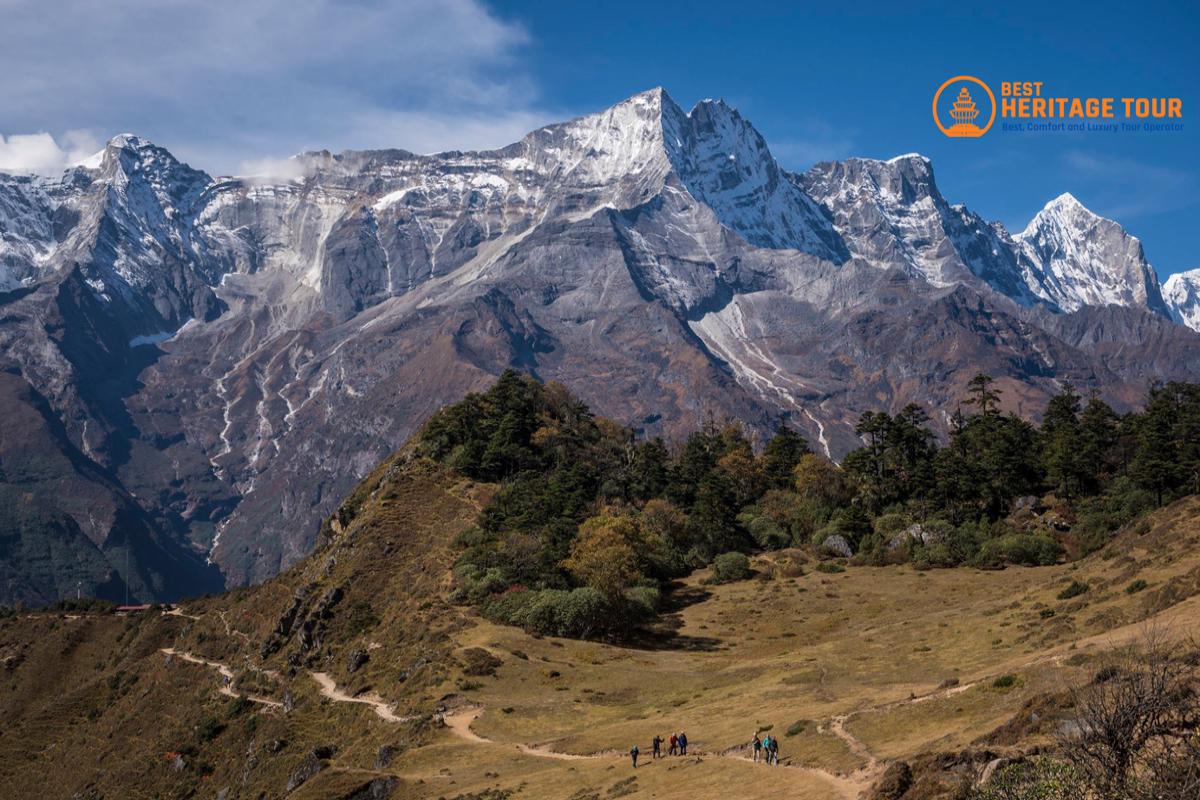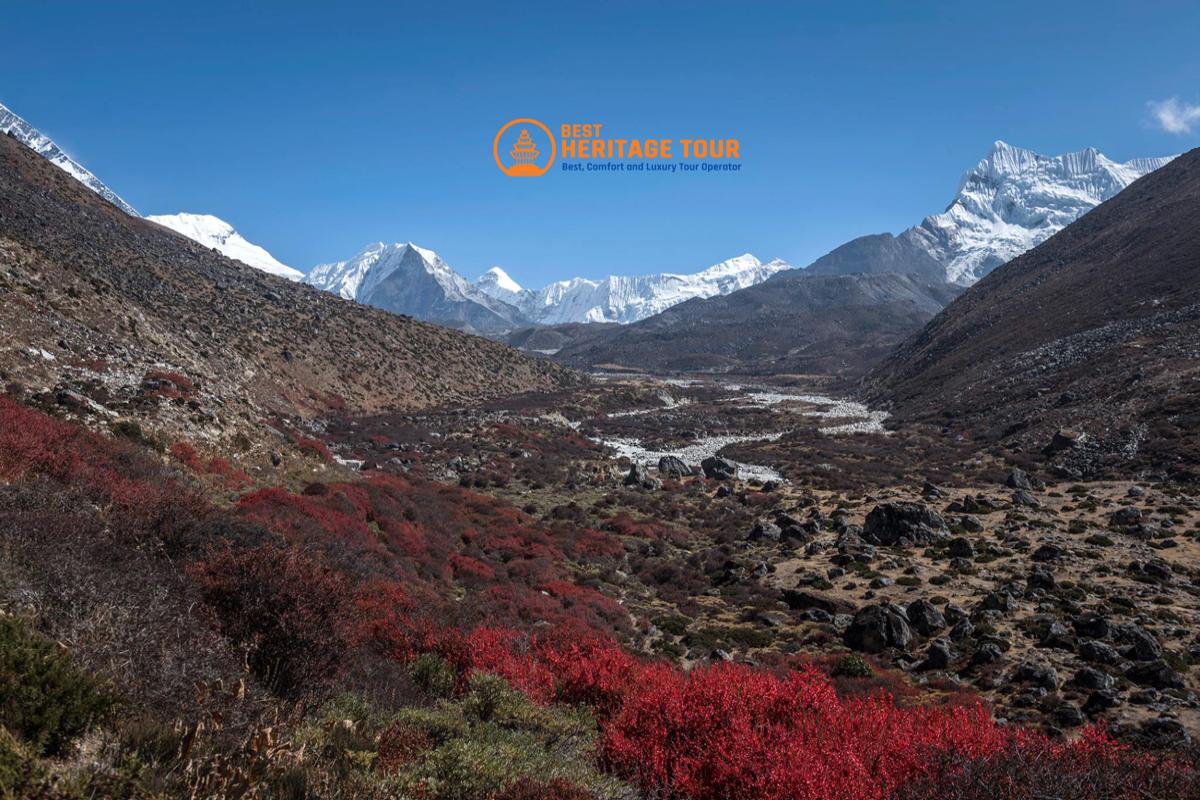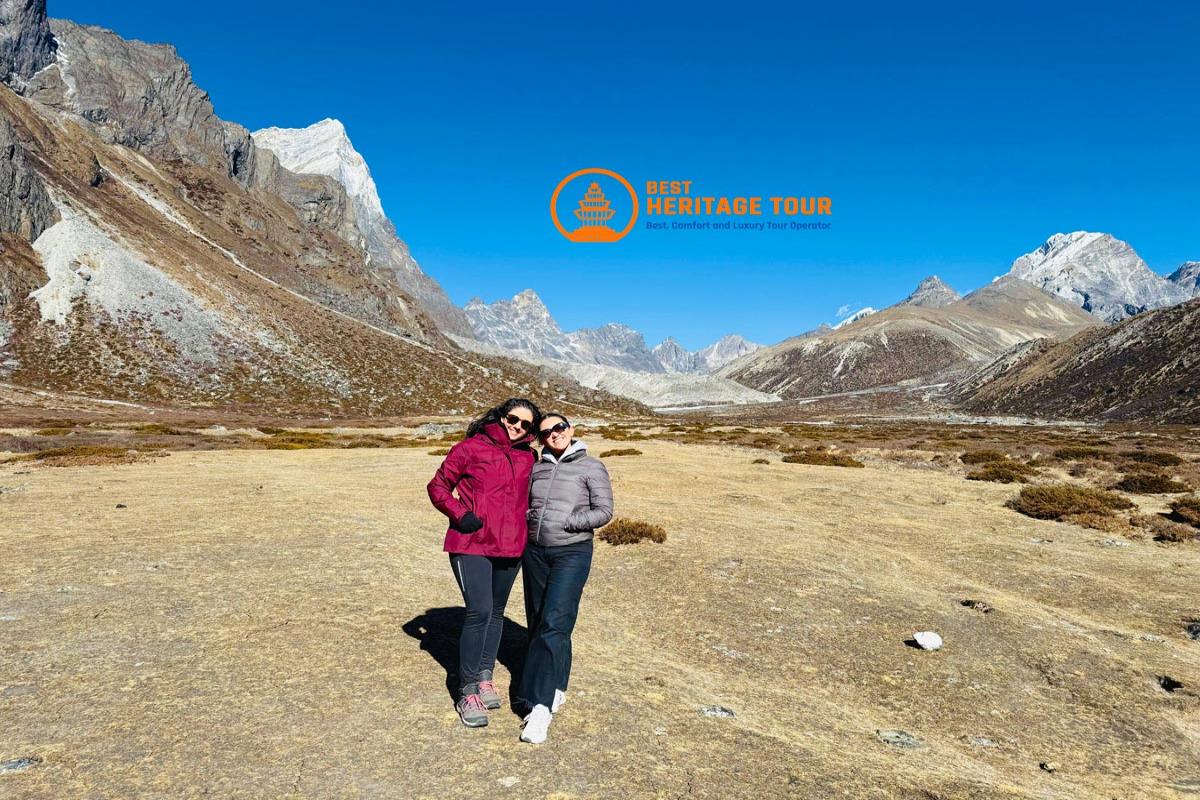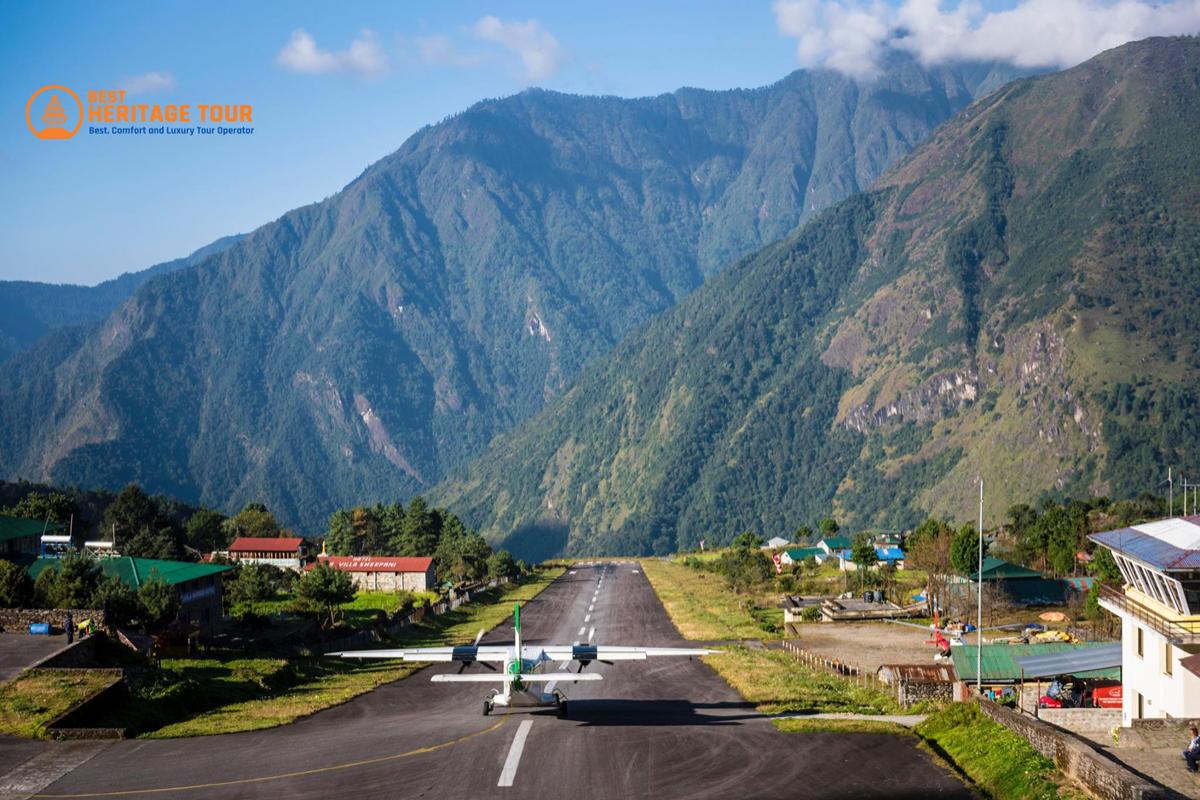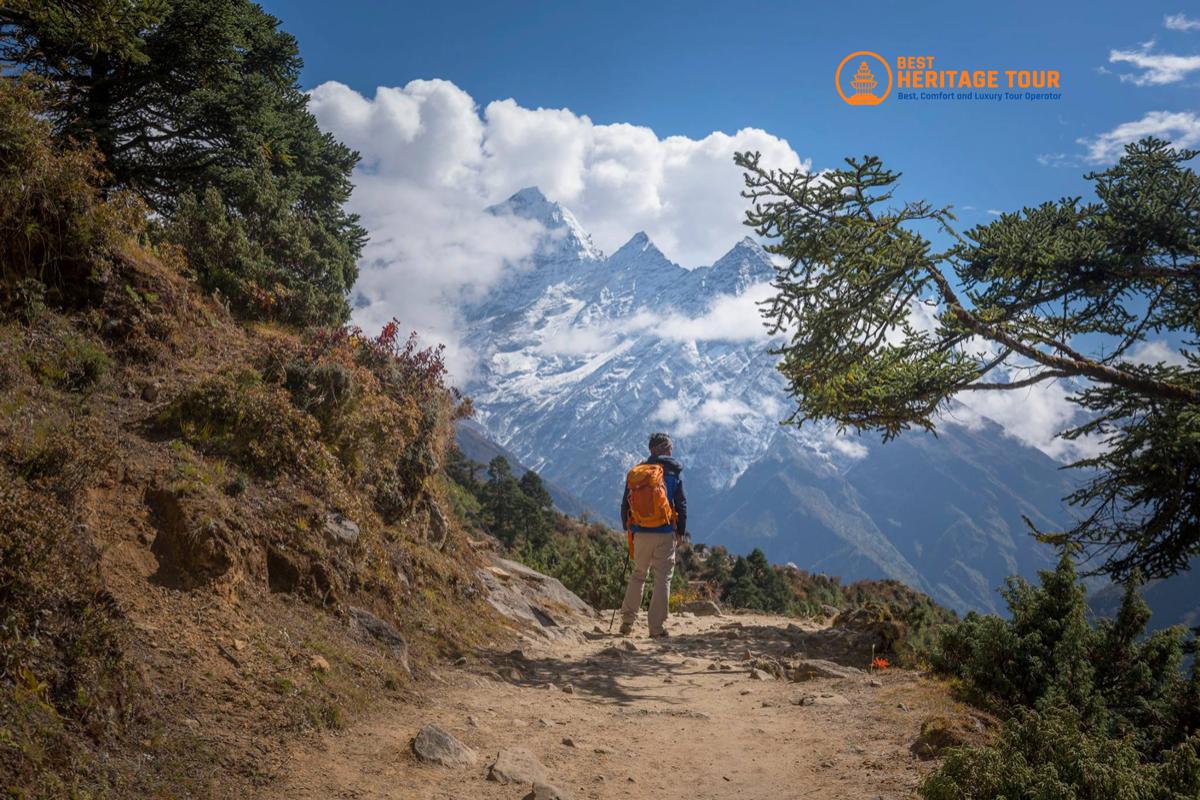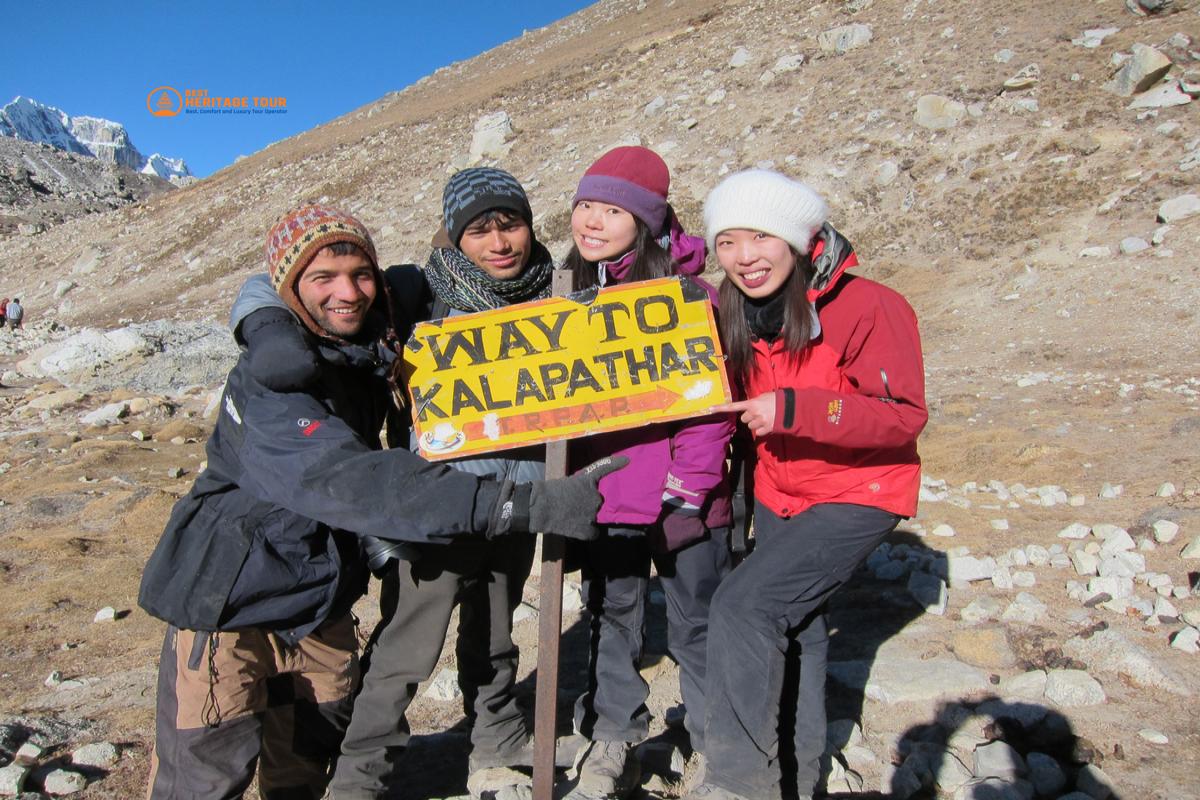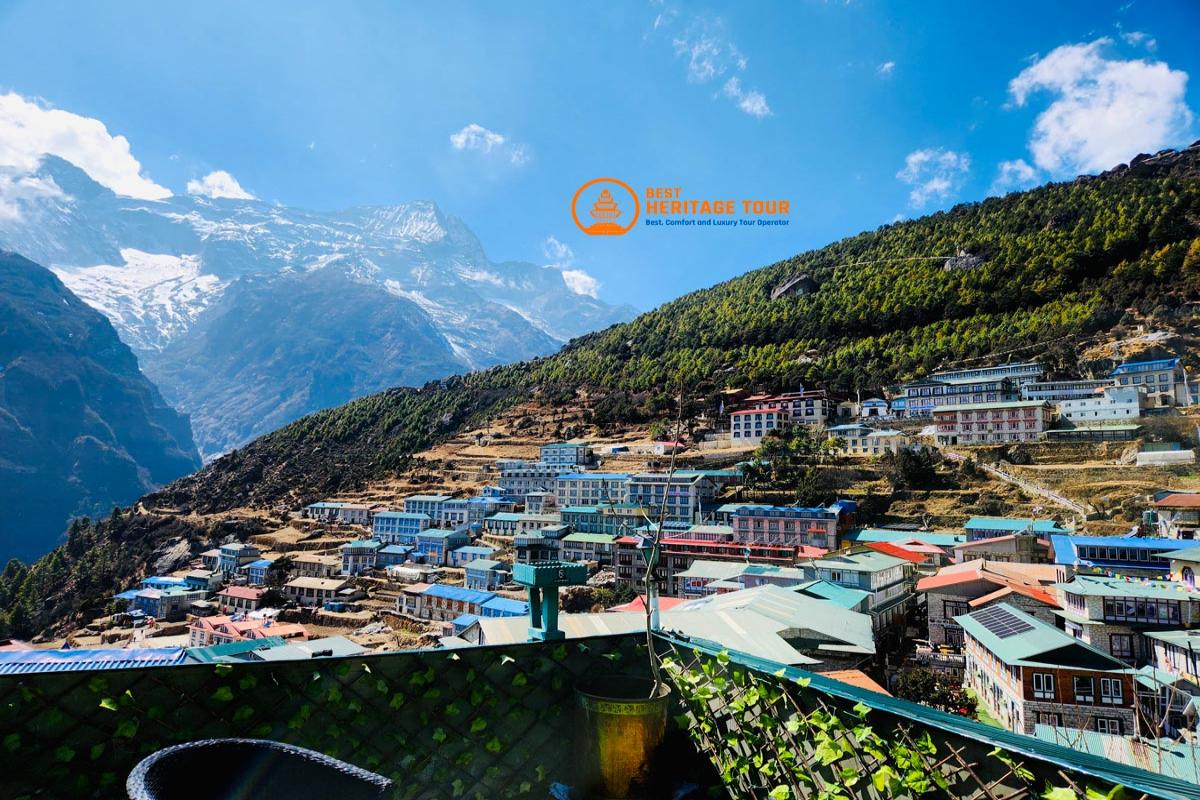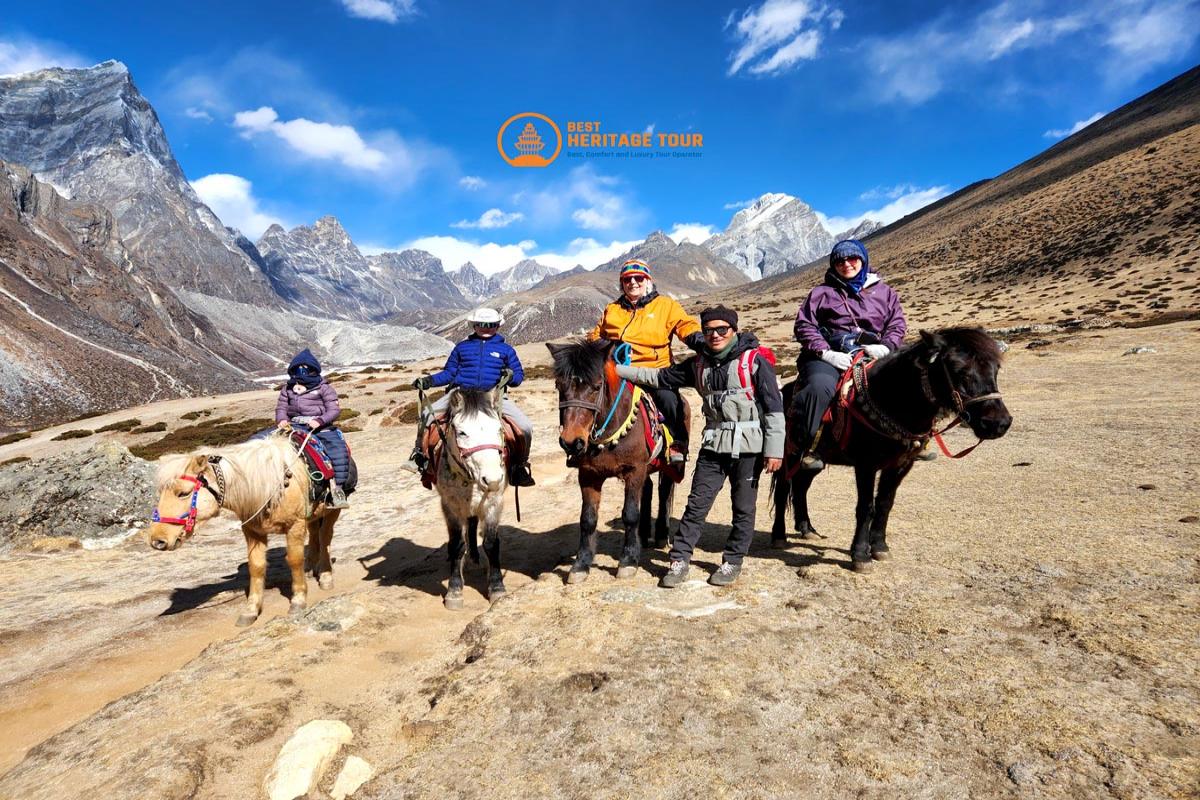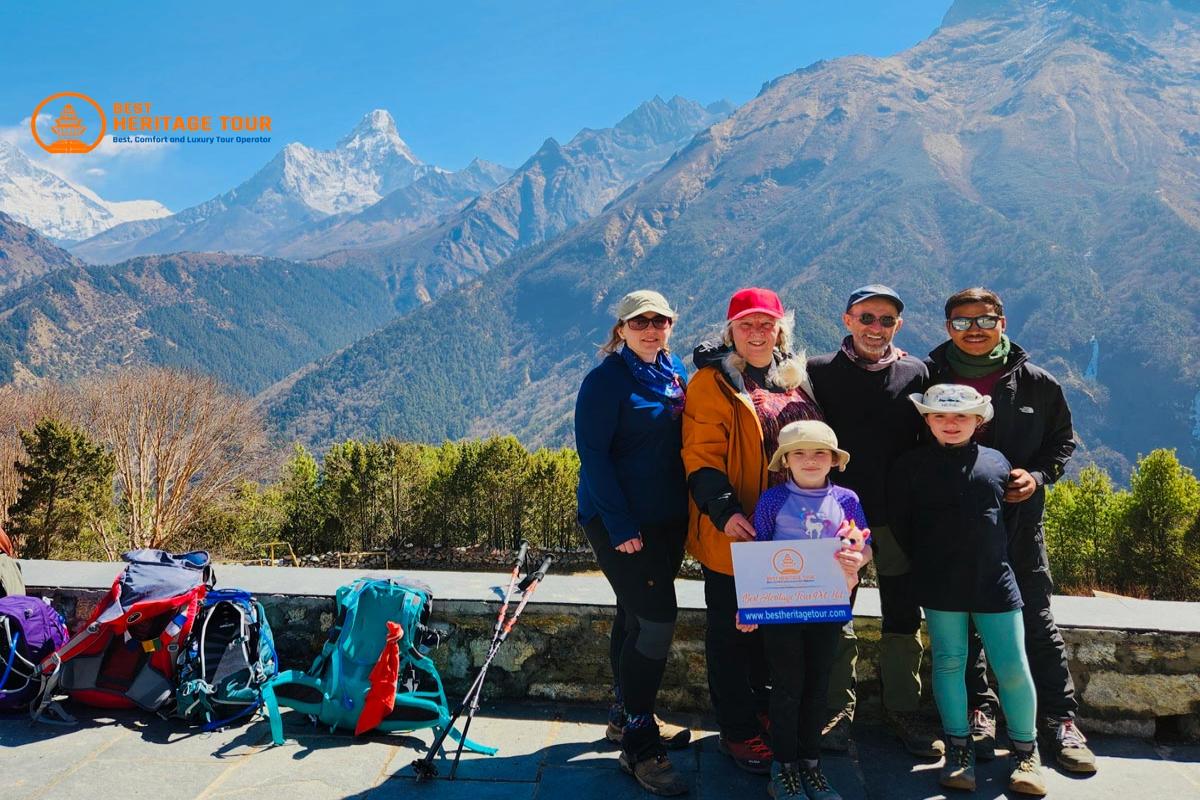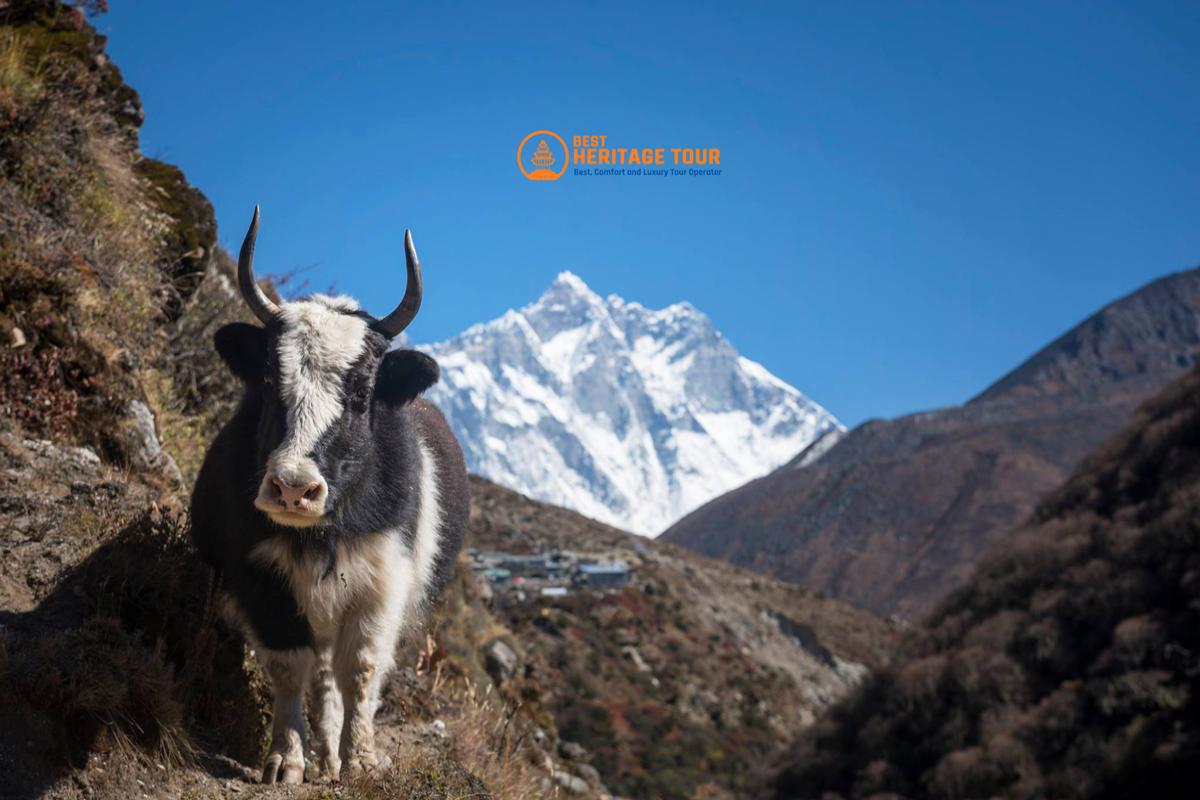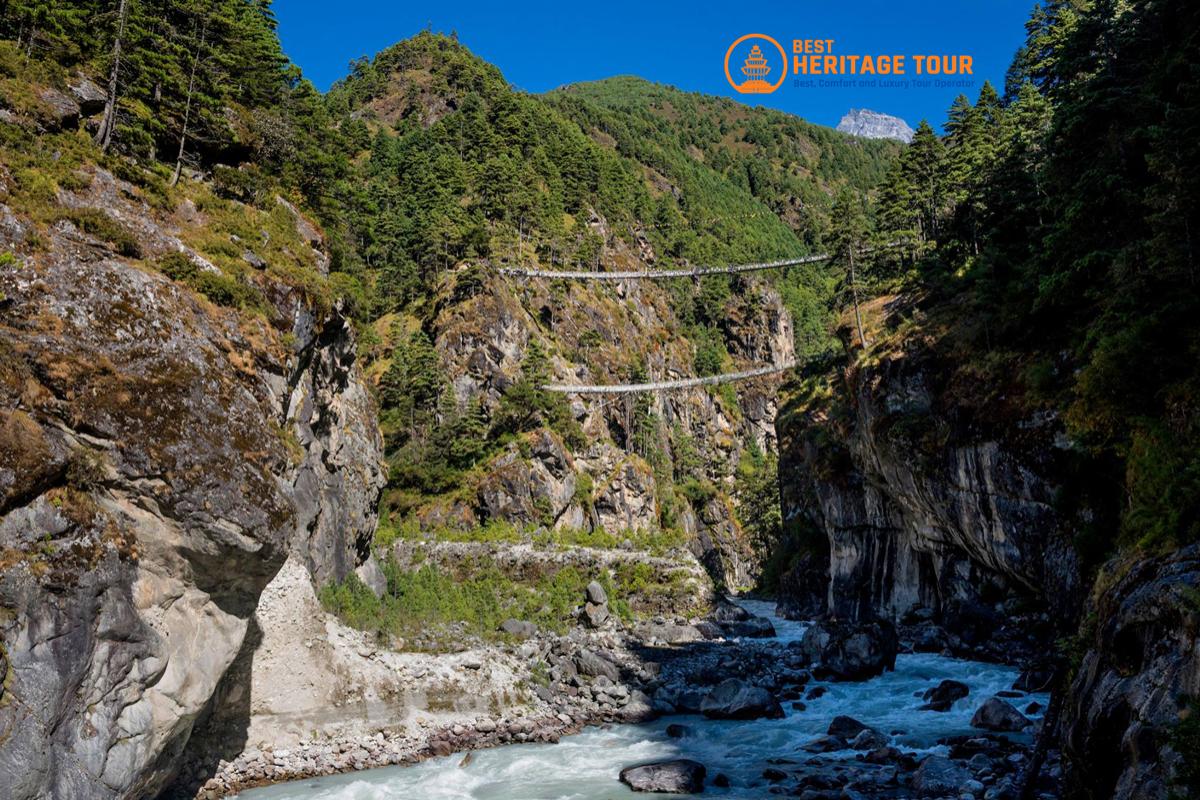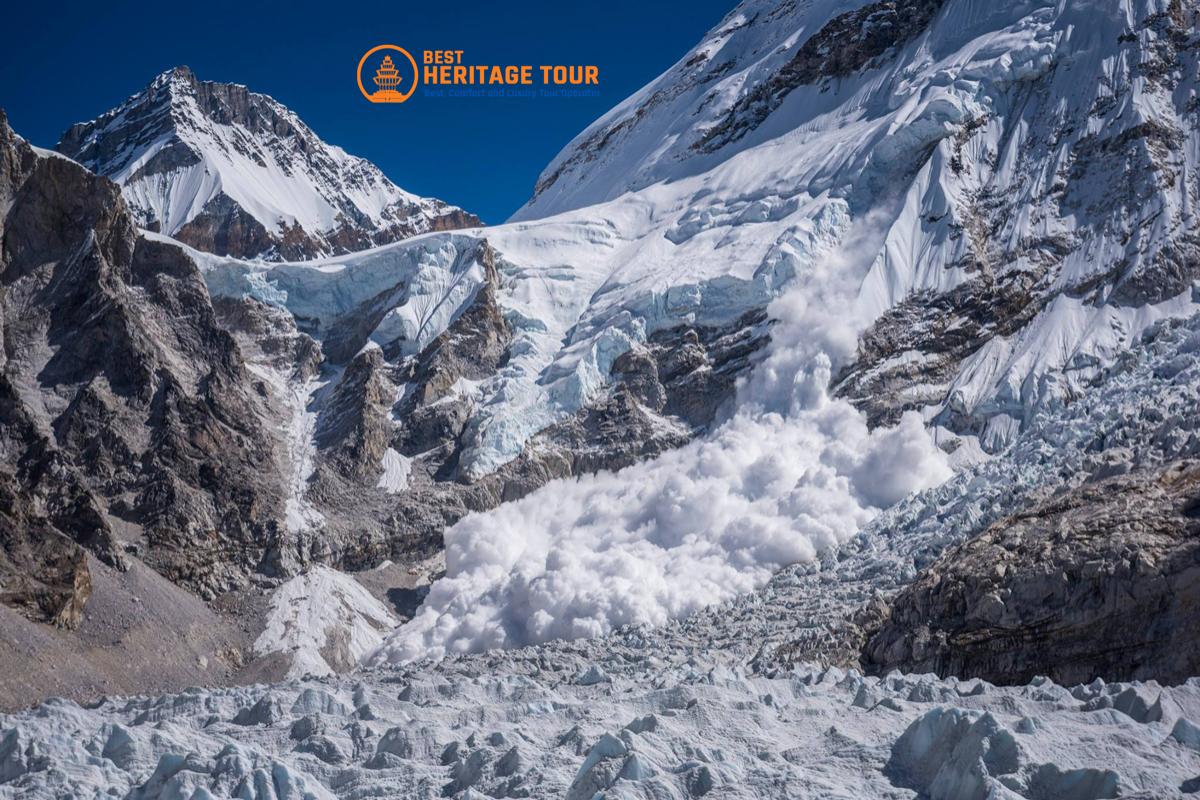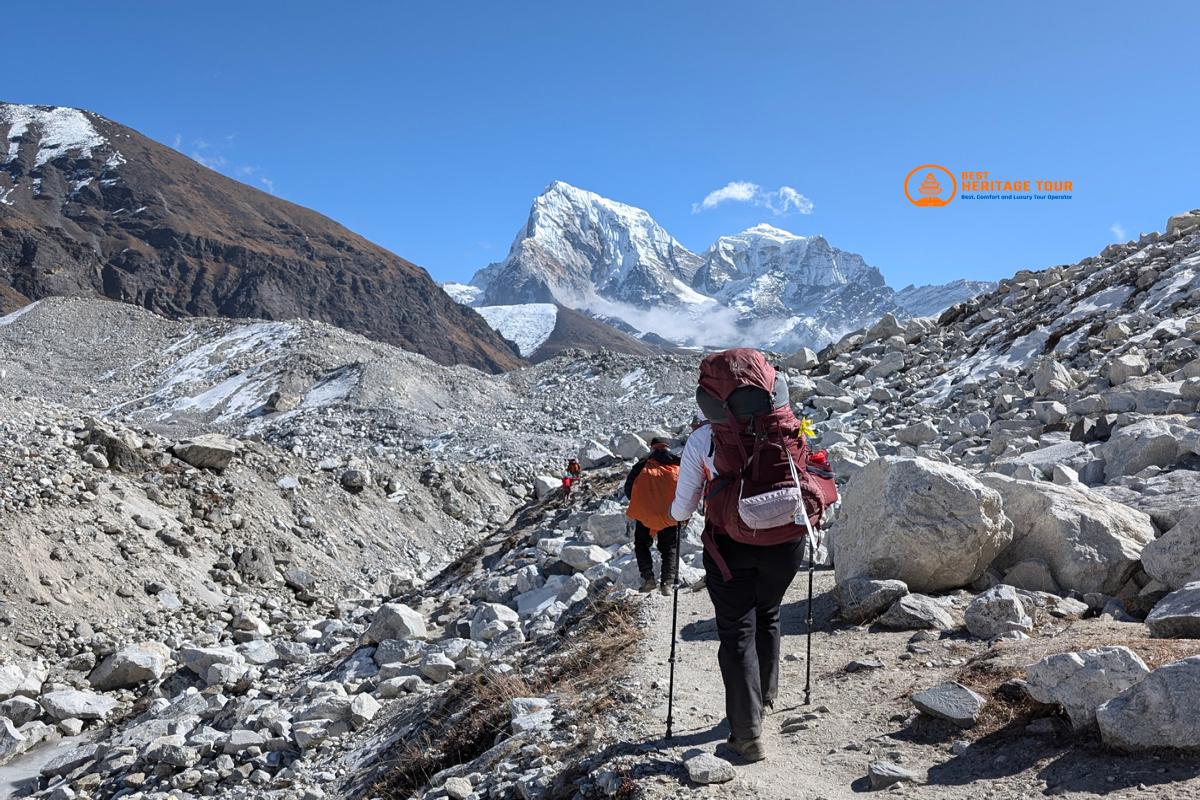Everest Base Camp Trek - 12 Days
Insights on the Mt. EBC Trek
Experience the exhilarating journey along one of the world's most thrilling trails, culminating at the impressive height of 5,555m at Kalapathar. Don't miss the opportunity to visit the renowned Everest Base Camp at 5,364m. Additionally, during your journey to Everest Base Camp, you will have the opportunity to immerse yourself in the captivating Himalayan landscape, diverse flora and fauna, and the rich Sherpa culture.
Trip at a Glance
Key Features of the Trek
- Visit one of the world's highest airports in Syangboche (3,780m / 12,402ft)
- Gain insights into the Sherpa culture and way of life
- Witness the majestic Mt. Everest (8,848.68m/29,029 ft.) up close
- Enjoy breathtaking views of other towering peaks such as Mt. Lhotse (8,516m), Cho Oyu (8,201m), and Mt. Makalu (8,463m)
- Encounter prayer wheels, vibrant flags, Mani stones (prayer stones), and impressive suspension bridges
- Explore a wide array of flora and fauna
- Discover a variety of wildlife such as musk deer, colorful pheasants, elusive snow leopards, and Himalayan Thars in their natural habitat.
- Discover the highest glacier on Earth- Khumbu Glacier (4,900m)
- Marvel at the stunning panoramic vistas from Kala Patthar (5,555m)
Advantages of EBC Trekking with Best Heritage Tour
- Airport pick up and drop off services in a private vehicle are provided at no additional cost for your convenience.
- Online trip briefing post-booking confirmation
- Provision of pulse oximeter for monitoring blood oxygen levels at high altitudes to detect early signs of altitude sickness and other health risks
- Availability of medical kits for emergencies
- Provision of sleeping bags and down jackets if needed
- Convenient booking and reservation process
- Multiple communication channels (Email, WhatsApp, Facebook, WeChat, Viber, Skype, Zoom)
- 24/7 phone support at +977-9851149197/+9779810043046
- Simple payment system
- Free storage for excess luggage at Best Heritage Tour store during the trek
- Duffle bags provided for porters
Lukla Flight Information
Please be advised that there could be minor changes to the trek itinerary, particularly during peak trek seasons (March, April, May, October, and November). The flight to Lukla will depart from Ramechhap/Manthali instead of Kathmandu due to traffic congestion. Outside of peak seasons, the flight will depart from Kathmandu. To board a flight from Ramechhap, it is necessary to depart from Kathmandu and travel to Manthali around 12:30 a.m. on the scheduled departure date. The journey will last approximately five hours.
Itinerary
The commencement of your journey may vary depending on the trekking seasons. If you are traveling during March, April, May, September, October, or November, please note that flights from Kathmandu to Lukla may be redirected to Manthali Airport. To board an early morning flight from Manthali to Lukla, our team will pick you up from your hotel at 12:30 am for a 5-hour drive to Manthali Airport. The flight duration from Manthali to Lukla is a swift 20 minutes, ensuring efficient travel for busy professionals on the go. For the remaining months (December, January, February, June, July, and August), you will have a direct flight from Kathmandu to Lukla.
For a more efficient journey, consider booking a helicopter from Kathmandu to Lukla to avoid the lengthy drive to Manthali. Kindly be advised that the price for reserving a helicopter amounts to approximately 570 US dollars per individual when split between a party of five.
Upon arrival at Lukla Airport, your adventure will officially begin. We will regroup at Lukla and commence our trek to Phakding, passing through Chaurikharka Village along the way. This trek will also assist in acclimatization. Since the trek is relatively short, we will take you to visit local monasteries around Phakding, including the renowned Rimishung Monastery.
We will be trekking along the northern bank of the Dudh Koshi River. The views from our path are absolutely breathtaking. As we cross numerous suspension bridges over the Dudh Koshi River, including the Hillary Suspension Bridge, we are filled with a sense of adventure and connection to nature. The path ahead will take us to the Sagarmatha National Park, where we will complete our permit registrations and venture into the dense forest to catch our first glimpse of Mt. Everest. However, our destination for the day is Namche Bazaar, also known as the gateway to Everest.
In order to ensure your body adjusts to high altitudes, we will be spending time at Namche Bazaar for acclimatization. Despite not engaging in trekking activities, there are plenty of things to keep you occupied in Namche.
Namche is home to a variety of hotels, restaurants, and cafes with Wi-fi connectivity. You can explore shops selling equipment and souvenirs. Additionally, we can visit attractions like the Hillary School, Sherpa Settlements, Syangboche Airport, Yak farms, and the Everest View Hotel, offering a magnificent view of Mount Everest.
Our journey commences in Namche, with Tengboche as our final stop. Along the way, we will be treated to breathtaking sights of Mt. Everest, Nuptse, Lhotse, and Ama Dablam. The path presents its challenges with its many ascents and descents. However, our hard work will pay off as we take in the magnificent scenery and catch glimpses of high-altitude wildlife like musk deer, pheasants, and Himalayan Thar. Prior to arriving at our final destination, we will be traveling through the quaint village of Phunki Thenga. The trails ahead will guide us to Tengboche, home to the renowned Tengboche monastery. The atmosphere here is serene and spiritually enriching.
Today, we will be departing from Tengboche and making our way to Dingboche. Along our route, we will encounter chortens, mani walls, and charming small villages, with the breathtaking sight of Ama Dablam stealing the show. Our journey continues next to the Lobuche River as we venture into Imja Valley, where a challenging ascent awaits us towards Dingboche. In Dingboche, you will observe cultivated fields shielded by stones to ensure the safety of the crops in this harsh environment.
Upon reaching Dingboche, you will have gained significant altitude, necessitating acclimatization. Today, we will dedicate our time to ascending the ridge above Dingboche, providing us with breathtaking, up-close views of the majestic snow-covered peaks - such as Lhotse, the rear Located on the side of Ama Dablam, Island Peak, Cho Oyu, and Makalu. Towards the north of Dingboche, we can witness more Himalayan peaks emerging over the Khumbu Khola valley. Dingboche village itself appears as though it has remained untouched since the beginning of time.
Our journey commences with a brief ascent from Dingboche. Subsequently, we will traverse a glacial moraine and a small cluster of accommodations. As the trek progresses, you will be treated to enhanced vistas of the mountains, culminating in the Thukla Pass, adorned with monuments dedicated to unsuccessful climbers. Overall, the trek promises to be a delightful experience, and upon reaching Lobuche, we will pause, rejuvenate, and lodge for the night.
Today marks the successful arrival at your final destination.The journey begins at Lobuche, passing through the lateral Khumbu Glacier moraine, until you arrive at Gorak Shep. Gorak Shep provides unparalleled views of the world's tallest mountains, making it a prime location for mountain enthusiasts. Our belongings will be left at Gorak Shep as we make our way to the Base Camp. This represents the peak attainable without the use of specialized tools. It is a remarkable accomplishment, a testament to your bravery and perseverance. You will likely reflect on this achievement and the memories associated with it for the rest of your life.
The ninth day signifies the peak of the journey. We will rise early in the morning and make our way to Kala Patthar to witness the sunrise over Mt. Everest and surrounding peaks. Kala Patthar is a renowned vantage point offering a magnificent panoramic vista of Mt. Everest and other peaks. Following our time at Kala Patthar, we will descend to Gorak Shep, enjoy breakfast, and take a brief respite. Subsequently, we will hike to Periche, our designated stop for the day.
You have been steadily progressing upwards, however, it is now time to descend. Our schedule includes waking up in Periche, having breakfast, and tracing the Dudh Koshi River to arrive at Namche Bazaar, where we will be staying overnight.
Our last day of trekking concludes with our return to Lukla. We will head back to the Dudh Kosi valley, experiencing entirely new views from this perspective. Our itinerary includes a stop in Lukla, where we will be staying overnight in preparation for our return flight to Kathmandu the following day.
Upon completion of your trek in Lukla, you have the option to either fly to Manthali or Kathmandu depending on the trekking season. Typically, travelers opt for a flight from Lukla to Manthali, followed by a five-hour drive to Kathmandu if trekking during peak months such as March, April, May, September, October, or November. Conversely, during off-peak months like December, January, February, June, July, and August, direct flights to Kathmandu are more common.
Reserve a helicopter from Lukla to Kathmandu to bypass the Lukla-Manthali-Kathmandu route. The additional cost for this service is around 570 USD per person when splitting the cost among five individuals, yourself included.
We anticipate that your return journey to Kathmandu will be a restful one. It is likely that you will reflect on the experiences you have had during this trip. Upon reaching Kathmandu, you are free to utilize your time as you see fit. DWT will coordinate the farewell dinner for you in the evening.
What is included?
- Purchase domestic flight tickets for the Kathmandu to Lukla route and back, including airport departure taxes.
- Enjoy a total of 11 nights on this trekking adventure. Stay five nights in Lukla, Phakding, and Namche (3 nights) with private attached bathrooms, and six nights in standard rooms at Tengboche, Lobuche, Dingbuche (2 nights), Gorak Shep, and Pheriche.
- Indulge in all standard meals during the trek, including 12 lunches, 11 dinners, and 12 breakfasts.
- Benefit from a government-licensed English-speaking trek leader. Groups of more than 12 trekkers will also have an assistant guide.
- Each trekker will have a porter to assist with luggage. Two trekkers will share one porter, with a maximum weight limit of 18 kg (9 kg per trekker). Store non-essential items at your hotel or at the BHT store.
- Your package includes compensation for guides and porters, meals, insurance, accommodation, transportation, airfare, and essential gear.
- Stay hydrated with water purification tablets provided for safe drinking water.
- Admission fee for Sagarmatha National Park is covered.
- Khumbu Pasang Lhamu Rural Municipality fees are also included.
- Enjoy daily snacks of cookies and seasonal fresh fruits.
- All government, local taxes, and official expenses are included in the package.
- Assistance is available for arranging rescue operations in case of complex health conditions (funded by travel insurance).
- Take home souvenirs of the company's T-shirt and cap.
- Receive a Best Heritage Tour Appreciation Certificate upon successful completion of the trek.
- Conclude your trek with a farewell dinner.
What is not included?
- Costs of international flights
- Nepal entry visa fee upon arrival at Tribhuvan International Airport - (30 days - $50)
- Charges for excess baggage (Limit is 8 kg per Person) during the trek
- Accommodation and meals in Kathmandu, before and after the journey
- Additional night accommodation in Kathmandu due to early arrival or late departure, or early return from the trek.
- Personal expenses (shopping, snacks, boiled bottled water, hot (tea / coffee) and cold drinks, hot shower, alcohol, Wi-Fi, telephone call, battery recharge fee, extra porters, etc.
- Personal clothing and gear
- Travel insurance covering emergency high-altitude rescue and evacuation (mandatory)
- Tips for guides and porters (recommended)
- Additional costs resulting from factors beyond our control, such as landslides, weather conditions, itinerary adjustments due to safety concerns, illness, changes in government policies, strikes, etc.
- All government taxes 13%, SSF, and 10% service charges
Route Map
Equipment
Head
- Sun protection accessories such as sun hats or scarves
- Winter headwear options like insulating hats or wide-brimmed hats
- Headlamps with spare batteries
Face
- High-quality sunscreen products
- Sunglasses with UV protection
- Face and body cleansing wipes
Hands
- Lightweight gloves for various activities
- Heavy-duty winter gloves for extreme conditions
Body
- Performance hiking shirts for optimal comfort
- Long-sleeved shirts for added protection
- Hooded rain jackets for unpredictable weather
- Fleece jackets for insulation
- Breathable lightweight cotton pants
- T-Shirts made from lightweight wool
- Polypropylene underwear for moisture management
- Down jackets, available for rent in Kathmandu
- Sweaters for additional warmth
- Waterproof jackets and pants for outdoor activities
Footwear
- Sturdy hiking boots for rugged terrains
- Thick wool socks, with an extra pair of lightweight socks for added comfort
Essential gear
- Backpack or daypack, depending on the need for a porter
- Thermal bottles for temperature control
- Water purification systems for safe drinking water
- Trekking poles for stability and support
- Sleeping bags, preferably rated for -15 degrees Celsius for high-altitude treks
Toiletries
- Medium-sized quick-drying towels
- Toothbrush and toothpaste
- Deodorant and dental floss
- Biodegradable bar soap
- Nail clippers
- Compact mirrors for personal grooming
Personal accessories
- Cash and financial essentials
- Watches for time management
- Cell phones for communication
- Cameras for capturing memories
Extra items
- Comprehensive first aid kits
- Additional passport photos and photocopies
- Notebooks and pens for documentation
- Binoculars for enhanced vision.
Trip Info
EBC : Trek Details
Complimentary Airport Pick-Up Service
Upon your arrival at the airport, one of our representatives from Best Heritage Tour will be there to greet you with a pamphlet bearing both your name and our company's name. As a token of our warm welcome, you will receive a traditional Khada or a colorful marigold garland. Subsequently, you will be escorted to your chosen hotel in Kathmandu.
Kathmandu offers a diverse selection of hotels, and we encourage you to select your preferred accommodation. Should you require assistance in finding a suitable hotel, kindly provide us with your flight information, and we will assist you accordingly.
Trek Orientation
Prior to your arrival in Nepal, we will conduct a comprehensive online orientation session. Additionally, a brief in-person orientation will be arranged in Kathmandu before we commence our journey together.
During this session, we will also conduct a thorough inspection of your belongings to ensure that you are equipped with all the necessary clothing, gear, and equipment essential for the trek.
Review
Best Tour Operator in Kathmandu
We booked a porter with Best Heritage Tours for our trek on the Everest Base Camp Trek. Both the booking of the porter and the arrangements with Best Heritage Tours worked...
View DetailEBC Trek - Thanks for the great Support
Our Trekking Tour was perfecty organised through Best Heritage Tour. We went with our family and did the EBC trek from Jiri for 20+ days. They organised a porter for us that was...
View DetailExcellent Trek with Best Heritage Tour
I recently completed a trek with Best Heritage Tour, and it was quite an experience from start to finish. Bimal did a very good job organizing everything. Professional and friendly...
View DetailAn Adventure of a Lifetime with Best Heritage Tour
The Everest base camp trek was absolutely exciting. This trek experience was adventuring in every single step, from those breathtaking views of Himalayas to the warm hospitality of...
View DetailUnforgettable Everest Base Camp Trek!
The EBC trek was truly one of the most memorable experiences of my life. Everything was well managed since my arrival in Kathmandu. Mr. Bimal Dhamala, who guided us, was very...
View Detailmy first EBC trek
I had never been on a multi-day trek before. I was very excited, just as nervous, about this Everest Base Camp Trek. The first trekking experience turned out to be quite...
View DetailThe Most Rewarding and Challenging Trek of My Life!
The Everest Base Camp Trek exceeded all my expectations.This journey wasn't just a trip. It put my stamina to the test, touched me, and gave me the thrill of a lifetime. The...
View DetailIncredible EBC Trek Experience
Reaching Everest base camp itself was an unforgettable adventure, but Best Heritage Tour really made it a difference. From the very first contact onwards, their attention and...
View DetailA memorable Himalayan trek with outstanding guides
Madhav, and assistant guide Milan worked so hard to make the entire 12-day high-altitude trek safe, comfortable, and really memorable. Their care and knowledge made all the...
View DetailUnique Experience at EBC
This 12 day Everest Base Camp trek was a fantastic adventure and one of the greatest experiences my wife has ever had. She has done many things in her life, but this one really...
View DetailEpic Everest Base Camp Trek with an Amazing Team
Without a doubt, the Everest Base Camp Trek was one of my best experiences ever! Everything was perfectly organized from permits to teahouse stays thanks to Best Heritage Tour. Our...
View DetailFAQ's
This trek offers breathtaking views of the Everest region, including the stunning Gokyo Lakes. It combines the classic trek to Everest Base Camp with a detour to Gokyo, renowned for its serene glacial lakes and spectacular mountain views.
Yes, the trek is accessible for beginners who are in good health and willing to acclimatize to higher altitudes.
Everest Base Camp serves as the primary hub for climbers preparing to conquer Mount Everest. It comprises two base camps: the South Base Camp in Nepal (5,364 meters/17,598 feet) and the North Base Camp in Tibet (5,150 meters/16,900 feet).
The standard trek to Everest Base Camp (South) typically spans 12-14 days, including necessary acclimatization periods. The duration outlined consists of 8 days allocated for the ascent to the base camp, followed by a return journey spanning 4-6 days back to Lukla.
Optimal trekking seasons for EBC fall during the pre-monsoon (March to May) and post-monsoon (late September to November) periods. These windows offer favorable weather conditions, clear skies, and enhanced visibility.
The trek presents difficulties due to the elevated altitudes and rough terrain. However, with proper preparation and determination, the journey is conquerable.
Yes, two permits are mandatory: the Sagarmatha National Park Entry Permit and the Khumbu Pasang Lhamu Rural Municipality Permit. If you plan on traveling through Jiri, please be advised that obtaining the Gaurishankar Conservation Area Permit is required.
Most trekkers opt to fly from Kathmandu to Lukla before commencing the trek to EBC. Alternatively, the less frequented route from Jiri is available, offering a longer trail.
Accommodations consist of teahouses, basic lodges providing rooms, meals, and communal areas. Room amenities typically include two single beds, with facilities becoming more modest at higher altitudes.
Vital gear comprises sturdy trekking boots, warm clothing, a cold-rated sleeping bag, a backpack, trekking poles, and a first-aid kit. Additionally, water purification tablets are recommended to reduce expenses and environmental impact.
Teahouses offer a range of meals centered around rice, noodles, and potatoes, with Dal Bhat being a staple dish. While water is available, purification methods are advised for safety.
Acclimatization plays a crucial role in averting altitude sickness. Trekking at a gradual pace, maintaining hydration, and adhering to recommended acclimatization periods are vital. Consultation with a medical professional regarding Diamox usage is recommended.
While independent trekking is feasible, engaging a guide and/or porter is strongly advised for safety, local insights, and navigation support. Guides can also assist with permits and accommodation arrangements.
Some teahouses offer Wi-Fi services for a fee, although connectivity may be limited, particularly at higher elevations. Cell service availability varies across regions, with inconsistent coverage.
Costs vary based on the trekking approach, with an average expenditure ranging from $1,000 to $3,000 USD. This budget encompasses permits, flights, accommodation, meals, and gear. Guided tours typically incur higher expenses but include additional conveniences.
In case of severe altitude sickness or emergencies, immediate descent to lower altitudes is imperative. Helicopter evacuation services are available but costly, underscoring the necessity of high-altitude trekking insurance coverage.
Weather conditions at EBC are unpredictable, with temperatures plummeting significantly, especially at night. Snowfall can manifest at any time of the year, emphasizing the need for preparedness and caution.
Absolutely! In addition to the Manaslu Circuit trek, Best Heritage Tours also organizes treks to other popular destinations such as Everest Base Camp, Annapurna Circuit, and Langtang Valley, offering a diverse hiking experience throughout Nepal.
Yes, all our guides are fluent in English and many speak other languages. This facilitates clear communication and enhances your overall experience.
Most trekking guides in Nepal speak basic to advanced English, which is enough for general communication about trekking and safety precautions. Some speak more fluent English, which will improve your overall trekking experience.
Yes, most visitors need a tourist visa to enter Nepal. A visa can be obtained on arrival at Tribhuvan International Airport in Kathmandu or applied for in advance at a Nepalese embassy or consulate.
Yes, you will need two passport-sized photos for both the visa application and the trekking permits, so it's a good idea to bring extra copies just in case.
You'll need a valid passport (with at least six months validity), a passport-sized photo, and the visa fee (which varies depending on the duration of stay).
To obtain the RAP, you’ll need:
- A valid passport.
- A Nepal visa.
- Travel insurance.
- Two passport-sized photos.
- A letter from your trekking agency detailing your itinerary and the names of the guide and group.
Yes, it’s possible to extend your visa if you wish to stay longer in Nepal. Extensions can be processed at the Department of Immigration in Kathmandu or Pokhara, but you should apply before your current visa expires.
You can exchange US dollars or Euros for Nepalese rupees upon arrival, but we recommend carrying cash in the local currency for most transactions outside of major cities.
Facilities may vary, but most teahouses offer the following:
- Basic bedding (mattress, pillow).
- A dining area for eating meals.
- Charging options for electronic devices (usually for a fee).
- Limited Wi-Fi access.
Hygiene standards may vary. Most teahouses strive for cleanliness, but it is wise to temper your expectations, especially in remote areas.
Yes, teahouses are generally safe and many hikers have had good experiences with them, but it's wise to use common sense, lock up your valuables, and choose a reputable establishment recommended by your guide.
To ensure you are comfortable while trekking, your backpack should ideally weigh 10-15% of your body weight, usually around 10-15 kg (22-33 lbs).
Physical preparation is essential to a successful trekking experience. Begin an exercise program 6-8 weeks before your hike that focuses on:
- Aerobic exercise: Activities such as running, cycling, and swimming to improve endurance.
- Strength training: Leg, core, and upper body exercises to increase strength.
- Practice hiking: Fill up your backpack and go on a short hike to simulate trekking conditions.
Hiring porters is not mandatory but highly recommended. Carriers allow you to carry heavy loads and make the hike more comfortable. This also supports the local economy and creates jobs in the area.
It is important to stay hydrated while climbing. Bring a reusable water bottle and use water purification tablets or a filter if necessary. Pack energy-rich snacks such as nuts, energy bars and dried fruit to maintain your energy levels throughout the day.
Before any hike, test your equipment on a training hike to make sure everything fits well and works properly. Ensure that you break in your trekking footwear to prevent blisters and discomfort.
Yes, we recommend that you have a small first aid kit with some basic items such as adhesive tape, disinfectant wipes, painkillers, altitude sickness medication, and personal medications.
Yes, you can rent trekking gear in Kathmandu and other major cities. However, we recommend that you check the quality and suitability of the equipment before renting.
Acclimatization helps your body adapt to high altitudes and reduces the risk of altitude sickness. Gradual ascents and rest days are essential to acclimatize effectively.
Pay attention to your body's signals, especially when fatigue sets in.
- Take a break: Take a break when necessary and find a comfortable place to sit and relax.
- Stay hydrated: Drink water regularly and eat snacks to replenish your energy.
- Inform your tour guide: Should you begin to feel unwell, it is important to communicate this to your tour guide. They can assist in modifying the pace and itinerary as needed.
Training at altitude helps your body adapt to lower oxygen levels, which can be beneficial for hiking. However, it is not absolutely necessary. Being in good cardiovascular condition can also prepare you for the conditions.
In the event of altitude sickness, it is vital to descend to a lower elevation immediately and take time to rest. Drinking plenty of fluids and taking over-the-counter medications (such as ibuprofen) can help reduce symptoms. See a doctor if symptoms persist.
Consult your doctor for individual vaccination recommendations. Common vaccinations climbers should consider include:
- Tetanus
- Hepatitis A and B
- Typhoid
- Rabies (if in contact with wild animals)
The main health risks while trekking include:
- Altitude sickness: occurs when you ascend too quickly without adequate acclimatization, causing symptoms like headaches, nausea, and fatigue.
- Dehydration: Insufficient fluid intake can cause fatigue and headaches.
- Injuries: Falls and slips on uneven surfaces can cause sprains and fractures.
Trekkers are strongly encouraged to take out travel insurance. Make sure your insurance covers high altitude hiking, medical evacuation and trip cancellation. This gives you peace of mind and financial protection in case of emergencies or unexpected events.
In case of emergency:
- Keep calm: Staying calm helps you make better choices.
- Contact your tour guides. They are trained to deal with emergencies and know what is best.
- Use communication devices: If necessary, you can use satellite phones and emergency transmitters for communication in remote areas.
In remote and secluded areas, maintaining a sense of connection can prove to be quite challenging.
- Cellular Network: Most areas along the trek have good mobile coverage, especially in larger villages such as Samagaon. However, signals can be unreliable.
- Wi-Fi Availability: Some teahouses offer Wi-Fi, but the connection can be slow and there may be a charge.
- Satellite Phone: If traveling to an area without cell coverage, consider renting a satellite phone in case of emergency.
Yes, Nepal offers an electronic visa (e-visa) that can be applied for online before arriving. This process enables you to bypass the visa queue upon arrival at the airport. After completing the online application, you can get your visa stamped on arrival.
The tourist visa fees are as follows:
• 15 days: USD 30
• 30 days: USD 50
• 90 days: USD 125 Note that these fees are subject to change, so check the current visa fees before your trip.
No, previous trekking experience is not mandatory. However, a good level of physical fitness is necessary, as the trek involves walking for 5-7 hours per day and ascending to high altitudes.
Most teahouses in remote areas do not allow online reservations. However, during peak seasons, guides or trekking agencies can help secure rooms in advance. It’s recommended to have a guide manage accommodations, especially in crowded seasons.
Yes, teahouses usually provide blankets, but they may not always be warm enough at high altitudes. Bringing your own sleeping bag rated for cold weather is essential.
Yes, it's recommended to bring your own trekking poles. They provide essential support during steep ascents and descents, and are particularly helpful for managing balance on rough terrain.
You should bring sturdy, waterproof trekking boots with good ankle support. Ensure they are well broken-in before the trek to avoid blisters or discomfort.
Start a fitness routine several months before the trek to gradually build strength and endurance. Even light to moderate exercise a few times a week can help condition your body. You can also opt for shorter and easier treks first to gain experience.
Yes, waterborne diseases are a concern in remote areas. Always drink purified or boiled water. Bring water purification tablets or a portable water filter to treat water from local sources.
Yes, if you wish to extend your stay, you can apply for a visa extension at the immigration office in Kathmandu or Pokhara.
While Nepali is the primary language, most staff members in lodges speak English, and some may even speak other languages. Communication should not be an issue for international tourists.
The Everest Base Camp Trek is a longer, more challenging journey that takes around 12-14 days, leading trekkers to the foot of Mount Everest at 5,364 meters. The Short Everest View Trek, on the other hand, is a 5-day trek offering a glimpse of Everest without reaching the base camp, focusing more on scenic views and cultural experiences at lower altitudes.
Yes, breakfast, lunch, and dinner are included during the trekking days. However, meals during your stay in Kathmandu may not be covered, depending on the package.
It’s advisable to be up-to-date on routine vaccinations, including hepatitis A and typhoid. Talk to your doctor about the vaccinations you need for Nepal.
While basic medical services can be found in larger villages such as Namche Bazaar, serious health concerns may require helicopter evacuation.
Hot showers are available in some teahouses for an extra fee, but Wi-Fi is scarce and often comes with additional costs.
- Cardio: Running, swimming, or cycling 3-4 times a week can improve endurance.
- Leg Strength: Include exercises like squats, lunges, and hiking on hilly terrain to prepare your legs for the varied elevation gains.
- Endurance: Long walks with a backpack, gradually increasing your distance and weight, will help your body adjust to carrying a load for extended periods.
Always check travel advisories from your government and the local situation before planning your trip. Nepal is generally safe for tourists, but it's wise to stay informed about political and environmental conditions.
Choosing the best heritage tour provides an enriching cultural experience, blending education, comfort, and unique local interactions for unforgettable travel memories.
The majority of international flights arrive at Tribhuvan International Airport, which is located in Kathmandu. From this location, travelers can connect to Lukla to commence their trekking journey.
You typically need a valid passport, a completed visa application form, and a passport-sized photo. Payment can be made in cash or via card at the airport.
Yes, tourist visas are eligible for extension at the Department of Immigration located in Kathmandu. Ensure you have a valid reason and required documents for the extension.
If you wish to extend your stay in Nepal beyond your visa’s initial duration, you can do so by applying at the Department of Immigration in Kathmandu. Extensions are available for a maximum of 30 days, and it’s recommended to apply before your current visa expires. Best Heritage Tour can help you with the extension process if required during your Australian Camp Trek.

